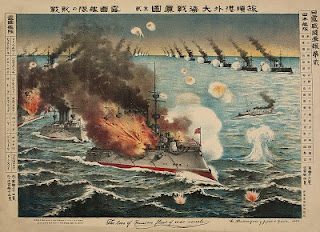It
all started with a surprise attack by the Japanese Navy. Japanese Navy destroyers raced
into Port Arthur , Manchuria
and attacked the Imperial Russian fleet at anchor on the night of 8-9 February
1904. This was the start of the Russo-Japanese War…. and a whole lot more.
The
Japanese used a similar surprise attack plan on the American fleet 37 years
later at Pearl Harbor .
Russians
were so surprised and disappointed with the failure of their Army and Navy in
the Russo-Japanese War that it was a major reason for the 1905 Russian
Revolution.
Photo, Russian Soldiers on
their way to the Front
The Russo-Japanese War happened 107 years ago,
just a few years after America
Our
President was Theodore Roosevelt, and he came into office sounding the alarm
for America
European
nations and the United States
had been showing much interest in capturing colonies and lucrative trading
partners in the Far East . The Boxer Rebellion
in Northern China had shown that the Chinese were not going to sit still for
western imperialists, and this was a fight that involved the U.S. , Britain ,
Germany , Austria-Hungary , Russia ,
Japan and Italy
This war pitted fierce-looking
Cossacks, and fur-hatted Russian infantrymen against equally-fierce looking
Japanese troops in the first large conflict of the Twentieth Century, and a
modern war that was a preview of things to come in World War II and beyond.
Fighting took place in Manchuria
and Korea
I’m often surprised at how much history many
of our young people have been able to tuck into their brains, in
addition to all that flurry of texting and video games and such.
I’m not old
enough to have been around for the Russo-Japanese War. Gosh, my Dad was five years old that year.
But for some
of us, history is like one big, delicious bowl of spaghetti, and it’s all
connected.
We lived
for two years in Russia , and
in Russia , everyone knows
about this 1904 war, and how the troops boarded the Trans-Siberian Railway and
went as far as Lake
Baikal Manchuria . They also know about the 18,000 mile trip
that Admiral Rozhestvensky took the Russian Fleet, from the Baltic, around
Africa, to an encounter with the Japanese Fleet in the Straits of Tsushima,
between Kyushu in Japan
Right after
living in Russia I lived for
three years in Sasebo , Japan , where everyone still celebrates Admiral
Heihachiro Togo Sasebo
If you’re
still with me on the “history as spaghetti” idea, you can draw connections
between the Japanese surprise attacks on Port Arthur
in 1904 and Pearl Harbor in 1941.
And you can connect up the dots
between Russian defeat in the Russo-Japanese War, and the 1905 Russian
Revolution, which led to the 1917 October Revolution, which gave the world
Communism and the USSR
You might enjoy the book listed
below, because it is filled with interesting pictures taken in St.
Petersburg and Lake Baikal , Russia , in Tokyo ,
Japan , and in Manchuria and Korea
Here’s the book that I just acquired:
Cover, The Russo-Japanese
War
Russo-Japanese War,
The: A Photographic and Descriptive Review of the Great Conflict in the Far
East; Large format book of pictures; Reporting and photographs by Davis,
Richard Harding; Palmer, Frederick; Archibald, James F.J.; Dunn, Robert L;
Bartlett, E.A.; Hare, James H.; Whigham, H.J. and Bulla, V.K. 1904. New York , NY
Story told in excellent black-and-white photographs of
conflict between Japan , only
recently a world power, and Russia ,
pushing eastward in Siberia, over Manchuria and Korea Battle St. Petersburg and Tokio (Tokyo Victoria Port Arthur Russia
We invite you to consider these items, as
well:
Crew of USS Yorktown. ca.
1898.
Uncle Sam's Navy, Historical
Fine Art Series, Vol. IV No. 3, April 26, 1898 Philadelphia , PA New York , deck crew of Yorktown, ship's
company of Maine
Farmers' Cabinet, The; Milford Advance and Wilton
Journal, Milford , NH
June 30, 1898 Rotch, W.B. Editor and Publisher 1898 Milford , NH New Hampshire paper concentrates on local news, with a drawing of Colonel J.A. Greene, the Fourth of July
orator for Milford Souhegan River (after the destruction of USS Maine in Havana Harbor Spain Cuba
includes report of U.S.
troops surrounding Santiago California Letter" details the extensive lines
of the Union Pacific in California ,
description of San Jose (San Hozay, it explains)
Pacific Grove , Monterey
and Santa Cruz
Century
Illustrated Monthly Magazine, The; January 1888
New York , NY Co. Union Square Rome
American Mercury, The, A
Monthly Review Edited by H.L. Mencken, June 1929 Mencken, H.L., Editor 1929 New York , NY Trenton America
Alaska-Yukon-Pacific Exposition: Report
of the Legislative Committee from the State of New York
to the Alaska-Yukon-Pacific Exposition, Albany Albany , NY : State of New
York New York
State was the only state east of the
Rockies to vote to appropriate money to take part in this exposition, held in Seattle , Washington New York New York State
Building , and of various New York New York
Contact me at scoulbourn1@verizon.net




















